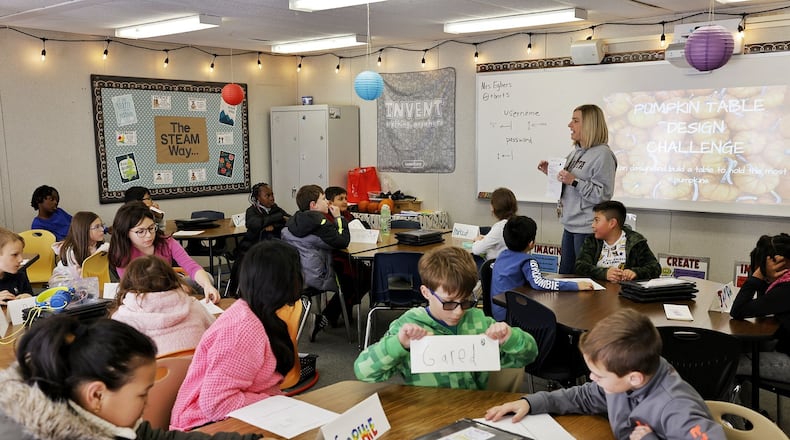Also on the ballot will be a permanent improvement tax levy request for renovation and maintenance of existing and new school buildings.
The Lakota Board of Education voted 4-1 – with member Isaac Adi opposing - to approve putting the proposed property tax increases on the Nov. 4 ballot to fund the district’s construction and renovation plans, which have been in public discussion and development for a half-decade.
Lakota officials also cited an opportunity to also use state school construction funding to offset millions of dollars in cost to local taxpayers should voters decide to approve the proposed 4.99-mill-bond issue.
Besides the 4.99-bond issue, voters will also decide on a proposed .95-mill permanent improvement tax to raise $4.98 million. Both are 37-year tax issues.
“This is about investing in the academic success of the next generation of Lakota students,” according to a statement from Lakota Schools Superintendent Ashley Whitely.
“Modern, well-equipped learning environments play a critical role in raising student achievement. With this bond issue, we have the opportunity to reduce overcrowding, lower class sizes and create spaces that support rigorous instruction, innovative teaching and student growth — while continuing to be mindful of the financial responsibility we owe our community,” said Whitely.
If both are approved by voters the total, combined millage of the two new tax increases would amount to a 2.66-mill jump in school taxes due to the maturation and phase out of an existing bonds in 2028, said Adam Zink, treasurer of Lakota Schools.
The resulting 2.66-mill property tax increase would mean annual school taxes for the owner of a $100,000 house would increase by a total of $93.10.
The 4.99 mill bond issue would provide $506.4 million, to be repaid over 37 years, for renovating and improving existing school facilities, constructing new buildings, reducing class sizes and enhancing safety and security.
“However, to protect taxpayers, the Lakota Board of Education has committed to limit total new tax collections at no more than 2.66 mills, or $93.10 per year per $100,000 of appraised property value. This is possible because of retiring school debt payments, current and projected property values, Lakota’s AA+ and Aa1 bond ratings and today’s interest rates,” said school officials.
“This fiscal cap was formalized through a (school board) resolution of intent and reflects conservative financial assumptions reviewed by independent advisors. Additionally, the new tax collections would not go into effect until 2029.”
Moreover, said officials, nearly a third of total facilities plan cost is estimated by Lakota officials to be covered under provisions of the district’s pending agreement with the Ohio Facilities Construction Commission (OFCC), but only if voters approve the two tax issues to assure local construction and renovation funding.
If the two tax issues win voter approval, by 2030 Lakota’s total number of school buildings, which have an average age of 35 years, will be reduced from 23 to 16 in West Chester and Liberty townships.
Lakota officials estimate, should the two tax issues be approved, new school buildings would be constructed and open prior to the 2028-2029 and 2029-2030 school years.
Under the district’s plan, some older schools would be closed in the coming years and four new elementary buildings would be built along with extensive renovations and expansions of two junior highs and the district’s two high schools – Lakota West and Lakota East.
With voter approval in November, phase one of Lakota’s Master Facility Plan, which includes additions Lakota East and West high schools, East Freshman and Plains Junior and moving to a 6-8 and 9-12 grades model, is scheduled to be completed by the start of the 2028-2029 school year.
Phase two, which includes building four new elementary schools and moving to a K-5 model, is scheduled to be completed by the start of the 2029-2030 school year.
More details on the proposed new school buildings and renovations of existing schools are available on the Lakota district website.
The district, which is the largest in Butler County and the largest suburban school system in southwest Ohio, enrolls more than 17,000 students.
The last time Lakota voters approved a bond issue for new school construction and building renovations was in 2005.
Under Ohio law, neither tax bond issue nor permanent improvement tax funds approved by taxpayers can be used by school districts for any expenses other than facilities construction, building renovations or building maintenance. No monies can fund operating costs such as labor costs or academic or other school programs.
Lakota Board of Education President Julie Shaffer said the two tax requests reflect the district’s commitment to fiscal responsibility.
“We know that trust is earned, especially when it comes to taxpayer dollars,” Shaffer said. “That’s why we also approved a resolution of intent that ensures the total new tax collections will be phased in so the millage collected will not exceed an additional 2.66 mills from what we will collect in 2026,” said Shaffer.
“This reflects conservative projections of future property values, our excellent bond rating and today’s interest rates.”
Lakota officials also announced a series of future public meetings, with dates to be determined, will be held in the coming months prior to the Nov. 4 election day to further gather input on the two tax issues and their potential impact on the school system.
About the Author
